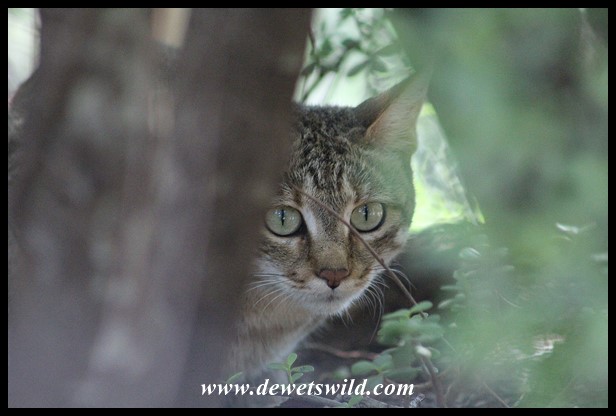Felis lybica cafra
The African Wild Cat is probably our most numerous small felid, occurring in every corner of South Africa and widely into the rest of the continent. They occur in any habitat that offers shelter and prey, which mainly includes rodents and other small mammals (up to the size of hares), birds, reptiles, frogs and invertebrates. They are independent of drinking water.
African Wild Cats are nocturnal and solitary by nature, except when mating or when a female is accompanied by her young. Both sexes defend territories, with those of males much larger and encompassing the areas of three or more females. Wild Cats are excellent climbers, though they do most of their hunting on the ground. Females give birth to litters of 1-5 kittens at any time of year, using burrows, holes in trees or crevices in rocks as dens. The kittens become independent when they’re around 5 to 6 months old, and have a life expectancy of up to 20 years.
Distinguishable from domestic tabbies by their relatively longer legs, shorter tails and rufous backs of the ears, the African Wild Cat stands about 35cm high at the shoulder and weigh around 4.5kg. It is estimated that African Wild Cats were first tamed about 10,000 years ago and is the direct ancestor to the our present day domestic cats. So closely related are they that hybridization with domestic cats is the single biggest threat to the continued survival of the pure African Wild Cat. The IUCN considers the African Wild Cat to be a subspecies of the European Wild Cat (Felis silvestris), a species it lists as being of least concern throughout its wide distribution.


















Pingback: Satara Summer 2021 – A not-so-wild African Wild Cat | de Wets Wild
An interesting collection of photos of a lovely though often elusive cat.
LikeLiked by 1 person
Thank you very much, Carol!
LikeLiked by 1 person
I am interested to note a number of your photographs are from Satara. That is where we experienced an African Wild Cat sleeping in the shade of our bakkie or in a tangle of bush and grass near our tent. We also had some exciting view of these cats in the Kgalagadi one year – they are a delight to observe.
LikeLike
You’ve mentioned the two best places I know of to find these cats, Anne. I don’t have a particular fondness for domestic cats, but I always appreciate an encounter with these!
LikeLiked by 1 person
You must stay up nights to capture these beautiful animals. Me… I’m in bed sleeping during those hours. >grin<
LikeLike
I must admit that I’m a bit of an insomniac when we’re out exploring South Africa’s wild places, John. I think I’m afraid I’ll miss out on something!
LikeLiked by 1 person
They do pretty much look like house cats with longer legs.
LikeLike
The common ancestry is clear to see
LikeLiked by 1 person
He is a bit smaller than the wildcats in the southern part of the US, but looks like he could catch what he wanted to. His face looks like one of the pets in our daughter’s house.
LikeLike
Beautiful creatures!
LikeLike
I like cats, for most of my life I’ve had cats as pets. The African Wild Cat is a good looking cat.
🙂
LikeLike
And an excellent mouser to boot!
LikeLike
nice share
LikeLike
Thanks very much
LikeLike
Love the glowing eyes. 🙂 Twenty years is quite a long life expectancy it seems. Hope you’re having a wonderful and healthy weekend.
janet
LikeLiked by 1 person
We’re perfectly fine, thanks Janet, and I hope the same goes for you and your family?
LikeLiked by 1 person
Yes, all healthy and doing well.
LikeLike
Wonderful to hear!
LikeLiked by 1 person